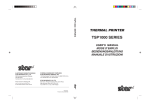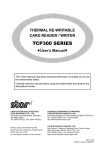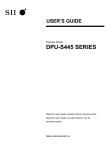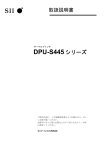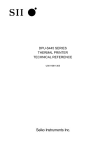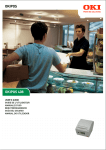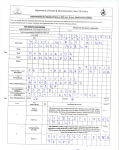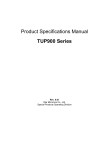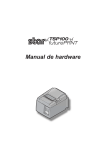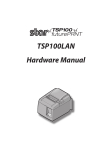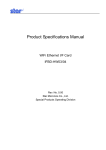Download Star Micronics TSP1000 User's Manual
Transcript
THERMAL PRINTER TSP1000 SERIES USER’S MANUAL Federal Communications Commission Radio Frequency Interference Statement This equipment has been tested and found to comply with the limits for a Class A digital device, pursuant to Part 15 of the FCC Rules. These limits are designed to provide reasonable protection against harmful interference when the equipment is operated in a commercial environment. This equipment generates, uses and can radiate radio frequency energy and, if not installed and used in accordance with the instruction manual, may cause harmful interference to radio communications. Operation of this equipment in a residential area is likely to cause harmful interference in which case the user will be required to correct the interference at his own expense. For compliance with the Federal Noise Interference Standard, this equipment requires a shielded cable. This statement will be applied only for the printers marketed in U.S.A. Statement of The Canadian Department of Communications Radio Interference Regulations This digital apparatus does not exceed the Class A limits for radio noise emissions from digital apparatus set out in the Radio Interference Regulations of the Canadian Department of Communications. Le présent appareil numérique n’émet pas de bruits radioélectriques dépassant les limites applicables aux appareils numériques de la classe A prescrites dans le Règlement sur le brouillage radioélectrique édicté par le ministère des Communications du Canada. The above statement applies only to printers marketed in Canada. CE Manufacturer’s Declaration of Conformity EC Council Directive 89/336/EEC of 3 May 1989 This product, has been designed and manufactured in accordance with the International Standards EN 50081-1/01.92 and EN 50082-1/01.92, following the provisions of the Electro Magnetic Compatibility Directive of the European Communities as of May 1989. EC Council Directive 73/23/EEC and 93/68/EEC of 22 July 1993 This product, has been designed and manufactured in accordance with the International Standards EN 60950, following the provisions of the Low Voltage Directive of the European Communities as of July 1993. The above statement applies only to printers marketed in EU. Trademark acknowledgments TSP1000: Star Micronics Co., Ltd. ESC/POS: Seiko Epson Corporation Notice • All rights reserved. Reproduction of any part of this manual in any form whatsoever, without STAR’s express permission is forbidden. • The contents of this manual are subject to change without notice. • All efforts have been made to ensure the accuracy of the contents of this manual at the time of going to press. However, should any errors be detected, STAR would greatly appreciate being informed of them. • The above notwithstanding, STAR can assume no responsibility for any errors in this manual. © Copyright 2004 Star Micronics Co., LTD. TABLE OF CONTENTS 1. Unpacking and Installation ............................................................................ 1 1-1. Unpacking .............................................................................................. 1 2. Parts Identification and Nomenclature ......................................................... 2 3. Consumable Parts and AC Adapter .............................................................. 4 4. Connecting Cables and AC Adapter .............................................................. 6 4-1. Interface Cable ....................................................................................... 6 4-2. Connecting to a Buzzer Drive .............................................................. 10 4-3. Connecting the Optional AC Adapter .................................................. 11 4-4. Turning Power On ...............................................................................12 4-5. Installing the Cable ..............................................................................13 4-6. Switch Blind Installation ..................................................................... 14 5. Control Panel and Other Functions .............................................................15 5-1. Control Panel ....................................................................................... 15 5-2. Errors ................................................................................................... 15 5-3. Self Printing .........................................................................................17 6. Loading the Roll Paper ................................................................................. 18 7. Adjusting the Near-end Sensor .................................................................... 21 8. Preventing and Clearing Paper Jams .......................................................... 23 8-1. Preventing Paper Jams .........................................................................23 8-2. Removing Paper Jam ........................................................................... 23 8-3. Releasing a Locked Cutter ...................................................................24 9. Periodical Cleaning ....................................................................................... 26 9-1. Cleaning the Thermal Head .................................................................26 9-2. Cleaning the Paper Holder ...................................................................26 Appendix A: Specifications ...............................................................................27 A-1. General Specifications .........................................................................27 A-2. Auto Cutter Specifications ...................................................................28 A-3. Interface ...............................................................................................28 A-4. Electrical Characteristics ..................................................................... 28 A-5. Option .................................................................................................. 28 A-6. Environmental Requirements............................................................... 29 A-7. Reliability ............................................................................................. 29 A-8. Black Mark Specifications ...................................................................30 Appendix B: Dip Switch Setting .......................................................................31 B-1. Parallel Interface Model .......................................................................32 B-2. Sperial Interface (RS-232C) Model .....................................................33 B-3. USB Interface Model ........................................................................... 35 B-4. Ethernet Interface Model ..................................................................... 36 Appendix C: Parallel Interface ........................................................................38 Appendix D: Serial Interface (RS-232C) ......................................................... 39 D-1. RS-232C Connector .............................................................................39 D-2. Cable Connections ...............................................................................41 D-3. Electrical Characteristics ..................................................................... 41 Appendix E: USB Interface and Ethernet Interface ...................................... 42 E-1. USB Interface Specifications ............................................................... 42 E-2. Ethernet Interface Specifications .......................................................... 42 Appendix F: Buzzer Driver Circuit .................................................................43 Appendix G: Memory Switch Settings ............................................................45 1. Unpacking and Installation 1-1. Unpacking After unpacking the unit, check that all the necessary accessories are included in the package. Paper stopper Switch blind Ferrite core *1 Fastener *2 User’s manual Printer *1: Not included with RS-232C model *2: Not included with RS-232C and USB models Fig. 1-1 Unpacking If anything is missing, contact the dealer where you bought the printer and ask them to supply the missing part. Note that it is a good idea to keep the original box and all the packing materials just in case you need to pack the printer up again and send it somewhere at a later date. –1– 2. Parts Identification and Nomenclature Printer cover Open this cover to load or replace paper. Cover open lever Push this lever in the direction of the arrow to open the printer cover. Control panel Power switch Used to turn on/off power to the printer. Features LED indicators to indicate printer status and switches to operate the printer. Power connector Interface connector For connection to a host computer. Buzzer drive connector Connects to buzzer. Do not connect this to a telephone. –2– For connection of the AC adapter. Never unplug the AC adapter while the printer is on. Choosing a place for the printer Before actually unpacking the printer, you should take a few minutes to think about where you plan to use it. Remember the following points when doing this. ✓ Choose a firm, level surface where the printer will not be exposed to vibration. ✓ The power outlet you plan to connect to for power should be nearby and unobstructed. ✓ Make sure that the printer is close enough to your host computer for you to connect the two. ✓ Make sure that the printer is not exposed to direct sunlight. ✓ Make sure that the printer is well away from heaters and other sources of extreme heat. ✓ Make sure that the surrounding area is clean, dry, and free of dust. ✓ Make sure that the printer is connected to a reliable power outlet. It should not be on the same electric circuit as copiers, refrigerators, or other appliances that cause power spikes. ✓ Make sure that the room where you are using the printer is not too humid. WARNING ✓ Shut down your equipment immediately if it produces smoke, a strange odor, or unusual noise. Immediately unplug the equipment and contact your dealer for advice. ✓ Never attempt to repair this product yourself. Improper repair work can be dangerous. ✓ Never disassemble or modify this product. Tampering with this product may result in injury, fire, or electric shock. –3– 3. Consumable Parts and AC Adapter When consumable parts have run out, use those specified in the table below. Make sure that the AC adapter specified in the table is used. Use of consumable parts or AC adapter which are not specified in the table may result in damage to the printer, fire or electric shock. (1) Roll paper specification Thermal paper Thickness: 80~105 µm Width: 82.5±0.5 mm Outer roll diameter: ø180 mm or less Take up paper roll width: 83 +0.5 -1 mm Core outer/inner diameter Core outer Core inner ø40±1 mm ø25.4±1 mm Printed surface: Outer edge of roll Tail end handling: Do not use paste or glue to secure the roll paper or its core. Do not fold the tail end of the paper. (2) Recommended paper Mitsubishi Paper Mills Limited T8037 (ticket), 85 µm (thickness) TF8067 (ticket), 84 µm (thickness) TF8075 (ticket), 84 µm (thickness) KANZAN KLS46 (ticket) KPO460 (ticket) Kanzaki Specialty Papers Inc. (KSP) Lotto482 (ticket), 84 µm (thickness) Depending on the type and thickness of the paper, it may be necessary to change the settings for printing darkness. To change the darkness settings, use the printing darkness settings command <ESC><RS> ‘d’ n or the memory switch settings. Refer to the separate Specification Manual for details. (3) AC adapter (option) Model name: PS60L-24 A Input: 100 to 240 V AC, 50/60 Hz Output: DC24±5%, 2.0 A (5.0 A Load 10 sec. Max.) –4– Important! Access the following URL for the information of the recommended paper. http://www.star-m.jp/eng/dl/dl02.htm –5– 4. Connecting Cables and AC Adapter 4-1. Interface Cable Note that the interface cable is not provided. Please use a cable that meets specifications. Important! Before connecting/disconnecting the interface cable, make sure that power to the printer and all the devices connected to the printer is turned off. Also make sure the power cable plug is disconnected from the AC outlet. 4-1-1. Serial Interface (RS-232C) Cable (1) Make sure the printer is turn off. (2) Connect the interface cable to the connector on the rear panel of the printer. (3) Tighten the connector screws. Serial interface cable –6– 4-1-2. Parallel Interface Cable (1) Make sure the printer is turn off. (2) For only the parallel interface model, affix the ferrite core onto the cable as shown in the illustration below. Ferrite core Interface cable 5 cm maximum (3) Pass the fastener through the ferrite core. Fastener Pull and cut (4) Loop the fastener around the cable and lock it. Use scissors to cut off any excess. –7– (5) Connect the interface cable to the connector on the rear panel of the printer. (6) Fasten the connector clasps. Parallel interface cable 4-1-3. Connecting USB Cable (1) Make sure the printer is turn off. (2) Affix the ferrite core onto the USB cable as shown in the illustration below and make sure to pass the cable through the cable support as shown in the illustration. –8– 4-1-4. Connecting Ethernet Cable (1) Make sure the printer is turned off. (2) Affix the ferrite core onto the ethernet cable as shown in the illustration below. Ethernet cable Ferrite core (3) Pass the fastener through the ferrite core. 10cm (Maximum) Fastener (4) Loop the fastener around the cable and lock it. Use scissors to cut off any excess. (5) Connect the ethernet cable to the connector on the interface board. Then, connect the other end of the cable to your computer. –9– 4-2. Connecting to a Buzzer Drive You can connect a buzzer drive to the printer using a modular plug. The following describes how to make the actual connection. See “Modular plug” on page 43 for details about the type of modular plug that is required. Note that this printer does not come with a modular plug or wire, so it is up to you to obtain one that suits your needs. Important! Make sure that the printer is turned off and unplugged from the AC outlet and that the computer is turned off before making connections. Connect the buzzer drive cable to the connector on the rear panel of the printer. Important! Do not connect a telephone line into the buzzer drive connector. Failure to observe this may result in damage to the printer. Also, for safety, do not connect wiring to the buzzer drive connector if there is a chance it may carry excess voltage. – 10 – 4-3. Connecting the Optional AC Adapter Note: Before connecting/disconnecting the AC adapter, make sure that power to the printer and all the devices connected to the printer is turned off. Also make sure the power cable plug is disconnected from the AC outlet. (1) Connect the AC adapter to the power cable. Note: Use only the standard AC adapter and power cable. (2) Connect AC adapter to the connector on the printer. (3) Insert the power cable plug into an AC outlet. Important! When disconnecting the cable, take hold of the cable connector to pull it out. Releasing the lock makes it easy to disconnect the connector. Pulling the cable excessively could cause damage to the connector. – 11 – 4-4. Turning Power On Make sure that the AC adapter has been connected as described in 4-3. (1) Set the power switch located on the front of the printer to on. The POWER lamp on the control panel will light up. Power switch Important! We recommend that you unplug the printer from the power outlet whenever you do not plan to use it for long periods. Because of this, you should locate the printer so that the power outlet it is plugged into is nearby and easy to access. – 12 – 4-5. Installing the Cable Install the cable as shown in the diagram below. – 13 – 4-6. Switch Blind Installation It is not necessary to install the switch blind. Only install it if it is necessary for you. By installing the switch blind, the following become possible. • Preventing the power switch from being operated by mistake. • Ensuring that other people can not easily operate the power switch. Install the switch blind as shown in the diagram below. The power switch can be turned ON (!) and OFF (O) by inserting a narrow instrument (ball pen etc) in the holes in the switch blind. Important! We recommend that you unplug the printer from the power outlet whenever you do not plan to use it for long periods. Because of this, you should locate the printer so that the power outlet it is plugged into is nearby and easy to access. – 14 – 5. Control Panel and Other Functions 5-1. Control Panel 2 FEED button 1 POWER lamp (Green LED) Lights when the power is ON 2 FEED button Press the FEED button to feed roll paper. 3 ERROR lamp (Red LED) Indicates various errors in combination with POWER lamp 3 ERROR lamp (Red LED) 1 POWER lamp (Green LED) 5-2. Errors (1) Automatically recoverable error POWER lamp ERROR lamp Recovery Conditions Head high temperature detection Flashes at 0.5 second intervals Off Automatically recovered after the print head has cooled. Cover open error On On Automatically recovered by closing the printer cover. Error Description (2) Recoverable error Error Description POWER lamp ERROR lamp Recovery Conditions Paper cut error Off Flashes at 0.125 second intervals Recovered If the cutter returns to the home position after turning the power OFF and ON. Note: 1) If the cutter doesn’t return to the home position, or doesn’t perform the initial movement, it cannot be recovered. 2) If the paper is jammed, turn the power off, clear the jammed paper, then turn the power ON. – 15 – (3) Non recoverable error Error Description POWER lamp ERROR lamp Recovery Conditions RAM error Off Flashes at 1.0 second intervals This is not a recoverable error. Consult dealer for repairs. EERROM error Off Flashes at 0.75 second intervals This is not a recoverable error. Consult dealer for repairs. Flash ROM error Off Flashes at 0.5 second intervals This is not a recoverable error. Consult dealer for repairs. Thermistor error Off Flashes at 1.5 second intervals This is not a recoverable error. Consult dealer for repairs. Power supply error Off Flashes at 2 second intervals This is not a recoverable error. Consult dealer for repairs. Note 1) If a non recoverable error occurs, turn the power OFF immediately. 2) When Power supply error occurs, there is a possibility that the power supply unit has a trouble. For other non recoverable errors, please consult the dealer for repairs. (4) Paper detection error Error Description POWER lamp ERROR lamp Recovery Conditions Paper out error On Flashes at 0.5 second intervals Automatically recovered by loading a new paper roll, then closing the printer cover. Paper near end On Flashes at 2 second intervals Indicators show that the paper end is approaching, but the printer continues to print. – 16 – 5-3. Self Printing (1) Test Printing Turn the power on while holding the FEED button depressed. Test printing will be performed according to the Ver. No., DIP switch settings and memory switch settings. (2) Hexadecimal Dump Mode Open the printer cover, then turn the power on while holding the FEED button. When the cover is closed, “*** HEX DUMP PRINTING ***” is printed, and the printer enters the Hexadecimal Dump Mode. Each of the signals sent from the computer to the printer will be printed out in hexadecimal code. This function allows you to check if a control code sent to the printer by the program being used is correct or not. The final line is not printed if its data is less than one full line. However, if the FEED button is pushed, the final line is printed. To turn off the mode, it is necessary to turn off the printer completely. – 17 – 6. Loading the Roll Paper Be sure to use roll paper that matches the printer’s specification. (1) Push the Cover open lever, and open the printer cover. Cover open lever Roll paper (2) While observing the direction of the roll, set the paper roll into the hollow, and pull on the leading edge of the paper toward you. – 18 – (3) Pull on the edge of the paper to remove any slack and then push down both sides of the printer cover to close. Note: Make sure that the printer cover is securely closed. (4) If the printer cover is closed after turning on the power, the cutter operates automatically and the front end of the paper is cut. Note: If the cutter does not operate after the printer cover is closed, open the cover and close it again securely. (5) If necessary, attach the paper stopper to the paper cover as shown below. The output tray can hold up to 30 sheets (thickness: 80–105 µm, length: 50–150 mm). Note: When attaching the paper stopper to the paper cover, position the stopper according to the length of the cut paper. (Refer to the following table.) Position 4 Position 3 Position 2 Position 1 Position 5 Position 6 Position 1 Position 2 Position 3 Position 4 Position 5 Position 6 – 19 – Paper length (mm) 50 – 100 100 – 120 120 – 140 140 – 160 160 – 180 180 – 200 Important! 1. Do not touch the cutter blade. · There is a cutter inside the paper outlet slot. Not only should you not put your hand in the paper outlet slot while printing is in progress, never put your hand into the outlet even when printing is not in progress. · The printer cover can be opened when replacing the paper. However, since the cutter blade is on the inside of the printer cover, be careful not to place your face or hands too close to the cutter blade. 2. Do not operate the cover open lever while pressing on the printer cover with your hand. 3. Do not pull out paper while the printer cover is closed. 4. The heating element and the driver IC of the thermal head are easily damaged. Do not touch them with metal objects, sandpaper, etc. 5. During and immediately after printing, the area around the thermal head is very hot. Do not touch it, as you could be burned. 6. Printing quality may suffer if the thermal head heating element becomes soiled by being touched with your hands. Do not touch the thermal head heating element. 7. There is a risk of damage to the driver IC of the thermal head from static electricity. Never directly touch the IC. 8. The printing quality and working life of the thermal head cannot be guaranteed if any paper other than that recommended is used. In particular, paper containing [Na+, K+, C1-] may drastically reduce the working life of the thermal head. Please exercise caution. 9. Do not operate the printer if there is moisture on the front surface of the head from condensation, etc. – 20 – 7. Adjusting the Near-end Sensor Use the following procedure to adjust the near-end sensor so it is compatible with the size of roll paper you are using. 1 Open the printer cover. 2 Determine the diameter of the roll paper you are using and find the required setting in the table below. 3 Insert the tip of a ballpoint pen or similar object into the hole of the adjuster, and then push and side the adjuster to the desired setting. When changing the setting, make sure that the position of the hole is aligned with the alignment mark indicated by the arrow. (Level 1) – 21 – (Level 2) (Level 3) Adjustment value according to the paper you are using Paper thickness (µm) When using the paper roll with a core whose inside diameter (A): ø25.4, outside diameter (B):ø32 Detected diameter (C) Remained paper length (Approx. mm) (Approx. m) Level 1 Level 2 Level 3 Level 1 Level 2 Level 3 ø44 ø48 ø52 10 14 19 6 9 12 85 105 C B A Roll paper core C Note: 1) The standard model is set to level 2 prior to being shipped from the factory. 2) The C dimension and the remained paper length are the calculated values. There may be some variations in actual mechanism. 3) The remaining paper lengths shown in the table above are for reference only. Adjust the near-end sensor to suit the actual conditions of use. 4) If thick paper is used (100 µm paper thickness), there will be looseness in the roll paper itself which makes it easier for detection variations to occur. Set to Level 3. – 22 – 8. Preventing and Clearing Paper Jams 8-1. Preventing Paper Jams The paper should not be touched during ejection and before it is cut. Pressing or pulling the paper during ejection may cause a paper jam, paper cutting failure or line feed failure. 8-2. Removing Paper Jam If a paper jam occurs, clear it as described below. (1) Set the power switch to off to turn off power to the printer. (2) Push the cover open lever, and open the printer cover. If the printer cover will not open on auto cutter models, it means that the auto cutter is not at the home position. In this case, return the auto cutter to the home position by following the instructions provided in section 8-3. Then open the printer cover after the paper jam has been removed. (3) Remove the jammed paper. Note: Take care not to damage the printer when removing the jammed paper. Since it is easy to damage the thermal head in particular, take care not to touch it. (4) Position the roll paper straight and close the printer cover gently. Note: 1) Make sure that the paper is positioned straight. If the printer cover is closed with the paper skewed, a paper jam may result. 2) Lock the printer cover by pressing down both sides. Make sure that the printer cover is securely closed. (5) Set the power switch to on to turn on power to the printer. Make sure that the ERROR LED is not lit. Note: While the ERROR LED is lit, the printer will not accept any commands such as the print command, so make sure that the printer cover is locked properly. – 23 – 8-3. Releasing a Locked Cutter If the auto cutter locks up or fails to cut the paper, follow the steps below. Caution Since working on the cutter may be dangerous, be sure to turn off the printer first. (1) Set the power switch to OFF to turn off the printer. (2) Slide off the front cover to reveal the auto cutter. (3) Remove any jammed paper. Note: Be careful not to damage the printer while removing any jammed paper. Since the thermal print head is particularly sensitive, be sure not to touch it. Front cover Tab – 24 – (4) If the cutter’s moving blade is protruding, rotate the knob in the direction of an arrow to return the moving blade to its home position. When the check window is completely white, the moving blade is at its home position. Note: 1) Do not apply extreme pressure to the moving blade. 2) If the moving blade is protruding too much, the printer cover cannot be opened. Trying to open the printer cover may damage the cutter. (5) Open the printer cover, remove any jammed paper, and then re-install the paper roll. (6) Install the front cover, and then set the power switch to ON. – 25 – 9. Periodical Cleaning Printed characters may become partially unclear due to accumulated paper dust and dirt. To prevent such a problem, paper dust collected in the paper holder and paper transport section and on the surface of the thermal head must be removed periodically. Such cleaning is recommended to be carried out once six month or one million lines. 9-1. Cleaning the Thermal Head To remove blackish dust collected on the surface of the thermal head, wipe it with Isopropyl alcohol (IPA). Note: The thermal head is easy to damage, so clean it gently with a soft cloth. Take sufficient care not to scratch it when cleaning it. 9-2. Cleaning the Paper Holder Use a soft cloth to remove paper dust from the paper holder and paper transport section. – 26 – Appendix A: Specifications A-1. General Specifications 249 (1) Printing method Direct line thermal printing (2) Print speed Max. 1440 dots/sec. (180 mm/sec.) (3) Dot density 203 dpi: 8 dots/mm (0.125 mm/dot) (4) Printing width Max. 80 mm (5) Number of print columns 53 (12 × 24 dots) (6) Roll paper Refer to chapter 3 for details on the recommended roll paper. Paper width: 82.5 ± 0.5 mm Roll diameter: ø180 mm or less (7) Overall dimension 161 (W) × 307 (D) × 249 (H) mm (8) Weight Approx. 3.0 kg (9) Noise Approx. 57 dB 161 307 Unit : mm – 27 – A-2. Auto Cutter Specifications (1) Cutting frequency (2) Thickness of paper Max. 20 cuts per minute 0.080 ~ 0.105 mm A-3. Interface RS232C serial interface/Two-way parallel interface (IEEE1284)/USB interface/ Ethernet interface A-4. Electrical Characteristics (1) Input Voltage DC 24V±10% (2) Current Consumption Operating: Approx. 2.0 A (at ASCII printing) Peak: Approx. 10 A (at print duty 100%, for 10 seconds or less) Stand-by: Approx. 0.1 A (3) Power Connector Pin No. Function 1 Drive power 2 Signal GND 3 N.C. Shell Frame ground 1 3 2 <Viewed from Connector Surface> Important! • When using a printer power supply other than the optional AC adaptor (PS60L-24A), be sure that the following cautions are observed. • Use a power supply of DC 24 V ±10% and more than 2.0 A (5.0 A Load 10 sec. Min) with SELV output approved by IEC60950. • Be careful about installing the printer in an area where there is noise. Take the appropriate measures to protect against electrostatic AC line noise, etc. A-5. Option (1) USB Interface Board Unit (IFBD-HU04) (2) Parallel Interface Board Unit (IFBD-HC04) (3) 25 Pin RS-232C Interface Board Unit (IFBD-HD04) (4) 9 Pin RS-232C Interface Board Unit (IFBD-HN04) (5) Ethernet Interface Board Unit (IFBD-HE04) – 28 – A-6. Environmental Requirements (1) Operating Temperature Humidity 5°C to 45°C 10% to 90% RH (without condensation) (%RH) 34°C90% RH 90 Relative humidity 80 40°C65% RH 60 45°C50% RH 40 Operating environment range 20 10 0 10 20 30 40 50 Temperature (°C) Operating temperature and humidity range (2) Transport/storage (except for paper) Temperature -20°C to 60°C Humidity 10% to 90% RH (without condensation) A-7. Reliability (1) LIFE (2) Cutter life 20 million lines (based on an average printing rate of 12.5% with paper thickness in the range 80 µm to 85 µm) 1.0 million cuttings (if the paper thickness is 100 µm or less) 0.3 million cuttings (if the paper thickness is more than 100 µm) – 29 – A-8. Black Mark Specifications Reverse side of the paper 1 +1 -0.8 mm Dimension A = 50 to 300 mm 5 ± 1 mm 15 mm or more 2.5 mm Printing direction Printing area Upper margin 12 mm or more Bottom margin Cut position The reverse side of the paper is the printing surface. (3 mm + dimension A × 3%) or more <Remarks> 1) The cut position shown above is when the print starting position correct value for Appendix G: memory switch 2 is the default setting. 2) The black mark’s PCS value must be 0.90 or more. 3) Note that accuracy of starting printing with the black mark sensor must be within ±2 mm of the standard printing positions, the printing length must be within ±2 mm of the set value in consideration of discrepancies occurring in the processing accuracy of the platen diameter and environmental temperature in the initial state, and a -5% error margin against the set value must be taken into account in consideration of life expectancy and attention paid to the print layout when using pre-printed paper. 4) The printing area must be within the usable range shown in the above diagram when using black marks. With regards to the top margin, approximately 11 mm is established between the print position and the cut position (auto cutter,) and the paper is fed through 1 mm or more (eight dot lines) if printing is performed after the cutting operations, making a total of 12 mm or more for the margin. Ensure that the margin shown in the above diagram is used to prevent the printing area value in the paper feed direction from exceeding the pitch of the black mark. Note that if this margin is not used, it may result in pages being skipped and other defects. [Example of the printing area setting] <When the pitch of the black mark (dimension A) is 100 mm> Top margin: 12 mm / bottom margin: 3 mm + (100 mm × 0.03) = 6 mm From this, it is clear that the printing area in the paper feed direction must be 82 mm or less. – 30 – Appendix B: Dip Switch Setting Two DIP switches are provided at the bottom of the printer, and can be set as given in the table below. Be sure to set the power switch to off before changing the settings. It is recommended to use a pointed item like a pen or flat-blade driver screw to change the settings. The settings will become effective when the power switch is set to on again. The following is the procedure for changing the settings on DIP switches. 1. Make sure the printer is turned off. 2. Remove the screw from the DIP switch cover. Then take off the DIP switch cover, as shown in the illustration below. 3. Set the switches using a pointed tool, such as a pen or flat-blade screwdriver. 4. Replace the DIP switch cover. Then secure it with the screw. The new settings take effect when you turn on the printer. – 31 – B-1. Parallel Interface Model ON ON OFF No. 1 2 3 4 5 6 7 8 OFF No. 1 2 3 4 DIP-SW2 DIP-SW1 DIP-SW 1 Switch Function 1-1 Command emulation 1-2 Command emulation ON OFF See table below 1-3 Should not be changed (Should be set to on) 1-4 Sensor adjustment Valid Invalid 1-5 Pin #31 (INIT) reset signal Valid Invalid 1-6 Handshaking conditions Offline or receive Receive buffer full (conditions for BUSY) buffer full 1-7 Automatic status back function Invalid 1-8 Should not be changed (Should be set to on) Valid The factory settings of DIP switch are all on. Switch 1-1 Switch 1-2 Command emulation ON ON Star Line Mode OFF ON Star Page Mode OFF OFF ESC/POS Mode DIP-SW 2 Switch Function ON OFF 2-1 2-2 2-3 Always ON Should be set to on 2-4 The factory settings of DIP switch are all on. – 32 – B-2. Sperial Interface (RS-232C) Model ON ON OFF No. 1 2 3 4 5 6 7 8 OFF No. 1 2 3 4 DIP-SW2 DIP-SW1 DIP-SW 1 Switch Function 1-1 Command emulation 1-2 Command emulation ON OFF See table below 1-3 Should not be changed (Should be set to on) 1-4 Sensor adjustment 1-5 Should not be changed (Should be set to on) 1-6 Valid Invalid Handshaking conditions Offline or receive Receive buffer full (conditions for BUSY) buffer full 1-7 Automatic status back function Invalid 1-8 Should not be changed (Should be set to on) Valid The factory settings of DIP switch are all on. Switch 1-1 Switch 1-2 Command emulation ON ON Star Line Mode OFF ON Star Page Mode OFF OFF ESC/POS Mode DIP-SW 2 Switch Function ON OFF 2-1 2-2 2-3 Always ON Should be set to on 2-4 The factory settings of DIP switch are all on. – 33 – The following is the procedure for changing the settings on DIP switch No. 3. 1. Turn off the printer and all components connected to it. 2. Remove the 2 screws. 3. Remove the serial interface board unit. 4. Change the setting of the DIP switches. 5. Replace the serial interface board unit. Then secure it with the screws. 6. Turn on the printer and all components connected to it. ON OFF No. 1 2 3 4 5 6 7 8 DIP switch 3 DIP-SW3 The factory settings of DIP switch are all on, except for switches 7 and 8. DIP-SW 3 Switch 3-1 3-2 3-3 3-4 3-5 3-6 3-7 3-8 Function ON Baud Rate OFF See table below Data Length Parity Check Parity Handshake 8 bits Disabled Odd DTR/DSR 7 bits Enabled Even XON/XOFF Should not be changed (Should be set to off) — — Baud Rate Switch 3-1 Switch 3-2 4800BPS 9600BPS OFF ON ON ON 19200BPS ON OFF 38400BPS OFF OFF – 34 – B-3. USB Interface Model ON ON OFF No. 1 2 3 4 5 6 7 8 OFF No. 1 2 3 4 DIP-SW2 DIP-SW1 DIP-SW1 Switch Function ON 1-1 Command emulation 1-2 Command emulation 1-3 Should not be changed (Should be set to on) OFF See table below 1-4 Sensor adjustment Valid 1-5 USB mode See table below Invalid 1-6 Handshaking conditions Offine or receive (conditions for BUSY) buffer fuu 1-7 Automatic status back function Invalid 1-8 Should not be changed (Should be set to on) Receive buffer full Valid The factory settings of DIP switch are all on. Switch 1-1 Switch 1-2 ON ON Command emulation Star Line Mode OFF ON Star page Mode OFF OFF ESC/POS Mode Switch 1-5 USB Mode ON Mode 1 (Printer class) OFF Mode 2 (Vendor class) Note: 1) A STAR USB Printer Driver Set is needed for using the USB interface on Windows 98 or 98SE . You can download the STAR USB Printer Driver Set from the following website. 2) Download the Mode 2 (vendor class) driver set from the following website for use. Printer Driver URL http://www.star-m.jp/eng/dl/dl02.htm DIP-SW 2 Switch Function 2-1~2-4 Always ON ON OFF Should be set to on The factory settings of DIP switch are all on. – 35 – B-4. Ethernet Interface Model ON ON OFF No. 1 2 3 4 5 6 7 8 OFF No. 1 2 3 4 DIP-SW2 DIP-SW1 DIP-SW1 Switch Function ON 1-1 Command emulation 1-2 Command emulation 1-3 Should not be changed (Should be set to on) OFF See table below 1-4 Sensor adjustment 1-5 Should not be changed (Should be set to on) Valid Invalid 1-6 Handshaking coditions Offline or receive Receive buffer full (conditions for BUSY) buffer full 1-7 Should not be changed (Should be set to on) 1-8 Should not be changed (Should be set to on) The factory settings of DIP switch are all on. Switch 1-1 Switch 1-2 Command emulation ON ON Star Line Mode OFF ON Star Page Mode OFF OFF ESC/POS Mode DIP-SW 2 Switch Function 2-1~2-4 Always ON ON OFF Should be set to on The factory settings of DIP switch are all on. – 36 – DIP-SW 3 LED DIP-switch 3 Switch Function 3-1 Always OFF 3-2 Initialization of settings 3-3 Always OFF 3-4 ON OFF Should be set to off Valid Invalid Should be set to off #9100 Multi-session (Maximum 8 sessions) Valid Invalid The factory settings of DIP switch are all OFF. The firmware must be ver.2.02 or later. ■ LED Display Green : Lights when other party connection is recognized as 10BASE-T. Orange : Lights when packets are received. Installing the Printer Driver and the LPR Port Driver Set To use the Ethernet interface from Microsoft’s Windows 95/98 and ME, the “Star LPR Port Driver Set” along with the printer driver is necessary. Download the Printer Driver and the Star LPR Port Driver Set from the following Web site. Printer Driver URL : http://www.star-m.jp/eng/dl/dl02.htm * To use Windows NT 4.0/2000/XP, the “Star LPR Port Driver Set” is unnecessary. – 37 – Appendix C: Parallel Interface The two-way parallel interface is compatible with the IEEE1284 compatibility mode and nibble mode. Refer to the separate Specification Manual for details. Table of Connection Signals for Each Mode Pin No. 1 2 3 4 5 6 7 8 9 10 11 12 13 14 15 16 17 18 19~30 31 32 33 34 35 36 Direction In In/Out In/Out In/Out In/Out In/Out In/Out In/Out In/Out Out Out Out Out OUT In Out In Compatibility Mode Signal Name nStrobe Data0 Data1 Data2 Data3 Data4 Data5 Data6 Data7 nAck Busy PError Select — — Signal GND Frame GND +5V Twisted Pair Return nInit nFault External GND — — nSelectIn Nibble Mode Signal Name Host Clock Data0 Data1 Data2 Data3 Data4 Data5 Data6 Data7 PtrClk PtrBusy/Data3,7 AckDataReq/Data2,6 Xflag/Data1,5 HostBusy — Signal GND Flame GND +5V Twisted Pair Return nInit nDataAvail/Data0,4 — — — 1284Active This connector mates with an Amphenol 57-30360 connector Parallel interface connector (printer side) Note: 1) The first letter “n” of each signal name indicates that the signal is active “L”. If any one of the above signals is not available, bidirectional communication cannot be accomplished. 2) In interfacing signals, be sure to use twist-paired wires for signal lines, and the return side must be connected to signal ground level. – 38 – Appendix D: Serial Interface (RS-232C) D-1. RS-232C Connector Pin No. Signal name Direction 25 Pin 9 Pin 1 F-GND — 2 3 TXD OUT 3 2 RXD IN 4 7 RTS OUT 5 6 N/C Function Frame ground Transmission data Receive data Same as DTR signal. Not used 8 CTS IN Status of this signal is not checked. 6 DSR IN STAR Mode Status of this signal is not checked. ESC/POS Mode In DTR/DSR communication mode, indicates whether data receive from host is enabled or disabled. Space: Receive enabled Mark: Receive disabled (except when transmitting data by DLE EOT, and GS a) This signal is not checked in the X-ON/X-OFF communication mode. — 7 5 S-GND 8~19 1,9 N/C 20 4 DTR Signal ground Not used OUT STAR Mode Indicates whether data receive from host is enabled or disabled. 1) DTR/DSR Communication Mode Space when receive is enabled. 2) X-On/X-Off Communication Mode Always space, except during following conditions: • Period between reset and communication enabled • During self printing ESC/POS Mode Indicates whether data receive from host is enabled or disabled. 1) DTR/DSR Communication Mode This signal indicates whether the printer is busy. SPACE indicates that the printer is ready to receive data, and MARK indicates that the printer is busy. The busy condition can be changed by using DIP SW 1-6 as follows: – 39 – Pin No. Signal name Direction 25 Pin 9 Pin Function DIP SW 1-6 Printer status OFF ON 1. During the period from when the power is turned on (including resetting using the interface) to when the printer is ready to receive data. BUSY BUSY 2. During the self printing. BUSY BUSY 3. When the cover is open. - BUSY 4. When the printer stops printing due to a paper-end. - BUSY 5. During macro executing standby status. - BUSY 6. When an error has occurred. - BUSY BUSY BUSY 7. When the receive buffer becomes full. 2) X-On/X-Off Communication Mode Always space, except during following conditions: • Period between reset and communication enabled • During self printing 21~24 N/C 25 INIT Not used IN Status of this signal is not checked. 13 1 D-sub 25 Pin 25 14 1 5 9 6 – 40 – D-sub 9 Pin D-2. Cable Connections The followings are a recommended interface cable connections. Printer side (D-sub 25 pin) Host side 25 pin 9 pin FG 1 1 TXD 2 2 3 TXD RXD 3 3 2 RXD RTS 4 4 7 RTS CTS 5 5 8 CTS DSR 6 6 6 DSR SG 7 7 5 SG DTR 20 8 1 DCD INIT 25 20 4 DTR FG Note: Use shielded wire less than 3m in length. Printer side (D-sub 9 pin) NC 1 RXD 2 TXD Host side 9 pin 25 pin 1 FG 2 3 RXD 3 3 2 TXD DTR 4 7 4 RTS SG 5 5 7 SG DSR 6 8 5 CTS RTS 7 6 6 DSR CTS 8 1 8 DCD NC 9 4 20 DTR Note: Use shielded wire less than 3m in length. D-3. Electrical Characteristics Voltage Data signal Control signal -3V to -15V Mark OFF 1 +3V to +15V Space ON 0 – 41 – Binary status Appendix E: USB Interface and Ethernet Interface E-1. USB Interface Specifications 1. General Specification: Conforms to USB 2.0 Specifications 2. Communication Speed: USB Full Speed Mode (12 Mbps) 3. Communication Method: USB Bulk Transmission Mode 4. Power Specifications: USB Self-power Function 5. Connector: USB Up-Stream Port Connector (USB Type-B) E-2. Ethernet Interface Specifications 1. General Specification: Conforms to IEEE802.3 2. Communication Media: 10 Base-T (Connectable to 100 Base-T) 3. Communication Speed: 12 Mbps 4. Protocol: TCP/IP 5. TCP/IP detail: ARP, RARP, BOOTP, DHCP, LPR, #9100, IPP, POP3, HTTP, TELNET, SMTP, SNMP 6. Connector: RJ-45 (8-pin modular) – 42 – Appendix F: Buzzer Driver Circuit This printer is equipped with a circuit for driving the buzzer. A 6-pin modular connector for connection of the buzzer is located on the back of the printer. To connect to the drive circuit, connect the buzzer to the modular connector using a cable supplied by you like that one shown in the figure below. Important! Never connect any other type of plug to the buzzer connector. Modular plug Modular plug: MOLEX 90075-0007, AMP641337, or JAPAN BURNDY B-66-4 Shield 1 6 Wire lead 1 Signal name FG Frame ground 2 DRV1 Drive signal 1 OUT 3 +24V Drive power OUT 4 +24V Drive power OUT 5 N.C. Not connected — 6 N.C. Not connected — Pin No. Function I/O direction — 6 1 <Viewed from Connector Surface> – 43 – Drive circuit The recommended drive unit is shown below. [ Drive Circuit ] 1 2 F.G 2SD1866 +24V M-GND 6 D1 7824 Buzzer 3 4 Drive Output: 24V, Max. 1.0A 1 6-P Modular jack connector Printer side User side Reference 2SD1866 Circuit Configuration C B R3 R4 E R3=3.5K R2=300 Note: 1) Pin 1 must be shield drain wire connected to buzzer device frame ground. 2) For continuous driving, Maximum drive output is 0.1A. 3) Absolute maximum ratings for diodes D1 (Ta = 25°C) is: Average Rectified Current Io = 1A 4) Absolute maximum rating for transistors 2SD1866 (Ta = 25°C) is: Collector current Ic = 2A – 44 – Appendix G: Memory Switch Settings Each memory switch is stored in EEPROM. For details on the functions and settings of memory switches, see the separate Specification Manual. The table below shows the factory settings for the memory switches. Memory Switch Hexadecimal Code 0 0000 1 2 0000 0000 3 0000 4 8 0000 0000 9 0000 Warning! Changing the memory switch settings can cause the printer to fail to operate correctly. – 45 – ELECTRONIC PRODUCTS DIVISION STAR MICRONICS CO., LTD. OVERSEAS SUBSIDIARY COMPANIES STAR MICRONICS AMERICA, INC. 536 Shimizunanatsushinya, Shizuoka, 424-0066 Japan Tel: 0543-47-0112, Fax: 0543-48-5013 1150 King Georges Post Road, Edison, NJ 08837-3729 U.S.A. Tel: 732-623-5555, Fax: 732-623-5590 STAR MICRONICS U.K. LTD. Please access the following URL http://www.star-m.jp/eng/dl/dl02.htm for the lastest revision of the manual. Star House, Peregrine Business Park, Gomm Road, High Wycombe, Bucks, HP13 7DL, U.K. Tel: 01494-471111, Fax: 01494-473333 2004.08.30 Printed in China, 80870405




















































